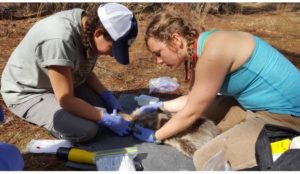Savannah River Ecology Lab raccoon study aims to eradicate rabies
Thomas Gardiner
Augusta Chronicle
Posted Feb. 14, 2017 | updated Feb. 15, 2017
Leaves crunch beneath the boots of four scientists as they make their way along a line of traps marked only by small, bright pink flags through the remote woods of Savannah River Site. In one trap, the crew finds a raccoon and quietly steps back to put their research plan into action.

Scientists at the University of Georgia’s Savannah River Ecology Lab have been studying to bolster efforts to eradicate rabies. Their work has gotten them up close and personal with a lot of area wildlife, especially raccoons.
“About 90 percent of all rabies cases reported in the United States are cases in wild animals,” said Dr. Guha Dharmarajan, head of the study. “Of those cases reported in wild animals, about 30 percent are in raccoons.”
Dharmarajan said efforts have been going on to fight rabies for years, including legislation requiring domestic cats and dogs be vaccinated. He said there is no treatment for rabies once the disease is contracted.
The seriousness of the disease is a major reason for continued studies, according to Dharmarajan. According to statistics from the World Health Organization, more than 55,000 people die worldwide each year from rabies – but only two or three of those happen in the U.S.
Just like efforts with polio and smallpox, these scientists hope to help eradicate rabies. Just as smallpox and polio were beaten with vaccinations, rabies in the raccoon population will be fought with vaccinations.
This vaccine doesn’t happen in a visit to a physician though. It will instead be administered orally through specially designed baits.
But raccoons aren’t alone on the 310 square mile expanse of SRS. They live in several different habitat types and compete for food with possums. Dharmarajan said the vaccines must reach 80 percent of the population before the disease will start to disappear into eradication. He said the biggest challenge is ensuring that threshold is met.
“We are trying to get good estimates of population sizes and find out how far they are moving. We have to also figure out how much of the population we are vaccinating, because some of the baits will be eaten by possums,” Dharmarajan said.
Scientists Dana Goin, Beckie Juarez and Jessica Buskirk worked together to tag the captured raccoon and collect important samples and other data.
“The sedative takes about a half an hour to wear off,” Buskirk said. “We want to watch for some head movement and we want to be away from the animal when it wakes up. Waking up to a bunch of giant people standing over it would be pretty terrifying.”
The team tracks the captured animals and will begin using tracking devices once the next phase of the study kicks off. The information collected can help them learn more about specific raccoon behavior and habitat usage. The study will also provide data about how far the young male yearlings travel when they set out for lives of their own.
Dharmarajan said the good access to a great population makes this an ideal place for the study because of the prevalence of rabies in raccoon populations and their large numbers in the Southeast. He noted that much of SRS is wooded and doesn’t see a lot of interaction with humans.
The captured raccoon was tagged and his data collected before Goin, Juarez and Buskirk returned the animal to the wild.
Dharmarajan said, “The hope is that by doing these kinds of vaccines you can eradicate this disease and then not worry about being infected or having your dogs or cats infected.”
He said rabies is spread primarily through bites from an infected animal, including bats, another significant rabies-carrying animal.
According to the WHO, it’s best to seek medical attention right away if you have any suspicion that you may have been bitten. The disease can be excruciating and fatal without receiving an injection of rabies immunoglobin.
Reach Thomas Gardiner at (706) 823-3339 or thomas.gardiner@augustachronicle.com
